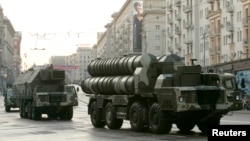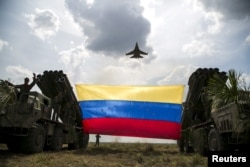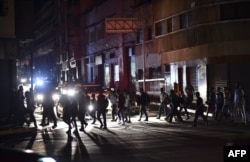Russian military personnel flying into Venezuela in recent weeks were likely sent to ensure the nation's sophisticated S-300 surface-to-air missiles remain a credible deterrent to any U.S. military action against the government of socialist President Nicolas Maduro, according to defense analysts in Latin America, the U.S. and Russia.
Analysts say the Russian military contingent, which reportedly arrived in late March, included air defense specialists with the necessary skills to ensure the decade-old missiles can be kept operational in spite of Venezuela's crumbling infrastructure and frequent power failures.
The Venezuelan government has displayed the S-300 missiles at military parades. U.S. Defense Department officials confirm their presence in the country, as do former Venezuelan military personnel. But few details have been revealed about their operational status or deployment.
According to defense experts in the region and satellite imagery obtained by the Israeli company Image Sat, at least four mobile batteries of S-300 missiles have been installed in different parts of Venezuela over recent months to protect key military bases and government centers.
U.S. President Donald Trump has left open the possibility of using force to oust Maduro and has repeatedly called on Venezuela's military to stage a coup in support of U.S.-backed parliamentary leader Juan Guaido. But prospects for an internal army uprising seemed to fade last week when the most senior general to publicly support Guaido, ex-intelligence chief Hugo Carvajal, was arrested on drug charges in Spain where he had gone into hiding.
Russian missile system
Venezuela acquired advanced S-300VM systems a decade ago when it was flush with oil money as part of an $11 billion package of Russian arms bought by Maduro's predecessor, Hugo Chavez. That package also included Sukhoi Su-30 fighter jets capable of delivering BrahMos cruise missiles, T-72 tanks, Komar torpedo boats and an assembly plant for AK-103 assault rifles.
"The S-300 is reckoned to be one of the best air defense missiles around and Russian motivation is probably twofold: to pose a challenge to the U.S. in its own backyard and to raise the costs to the U.S. of any invasion of Venezuela," said Nigel Inkster, an international security expert with London's International Institute for Strategic Studies.
The missiles have proliferated in other conflict zones such as the Middle East, where Iran acquired S-300s to protect its nuclear installations from any U.S. or Israeli air attacks. Russia has supplied S-300s to Syria, while Turkey is negotiating to purchase the even more advanced S-400 system.
Venezuela originally purchased eight batteries consisting of multiple tube erector launchers on tracked vehicles. The S-300 fully automated radar guidance systems — managed from mobile command posts — are capable of intercepting cruise missiles, fixed-wing aircraft and unmanned drones, and countering electronic countermeasures by filtering out false targets.
At least four S-300 batteries have been delivered to Venezuela, according to Jose Marulanda, a U.S.-trained Colombian intelligence officer and leading defense analyst in Latin America. He says that 100 Russian servicemen who landed in Caracas on board Antonov and Ilyushin military transports at the end of March have the mission of "refurbishing" the system to get it up and running to mount a defensive air screen over the center of the Venezuela.
According to Venezuelan exiled admiral Ivan Carruto, a former spy chief who is in close touch with elements in Venezuela's military, S-300VM batteries have been installed near Caracas as well as the main naval base and oil terminal of Puerto La Cruz. They are also deployed on Margarita Island — covering Venezuela's northern approaches — and Guarico, a key military complex in the country's interior where Su-30 warplanes and T-72 tanks are also based with Russian maintenance crews.
Guarico also holds the tracking station for the Simon Bolivar satellite that was launched by China about 10 years ago to provide Venezuela's military with advanced capabilities to control national territory and communications, forming a key element in the Maduro government's ability to counter internal unrest.
Countering power failures
Much of Venezuela's economy has collapsed, with food, medicine and power shortages affecting large portions of the population. But Russian advisers are "operating under extreme conditions" to keep the military machine going, according to Moscow defense expert Oleg Morozov, who spoke on Russian television about President Vladimir Putin's growing commitment to protect Maduro.
One of the main tasks of the recently arrived Russian air defense specialists is "setting up autonomous power generation systems to secure the capacity of S-300 systems to function during power cuts," according to Marulanda. The Russians arrived on March 24, less than three weeks after a nationwide power failure blacked out most of the country on March 7.
S-300 missiles have a standard range of 200 kilometers, although recently enhanced versions can reach targets at almost twice that distance, according to Russia arms contractor Rosoborexport, which has managed the sales to Venezuela.
"They may present a serious consideration for any planning action against Venezuela, but are not a game changer," said professor Ewan Ellis, a Latin America expert with Center for Strategic and International Studies in Washington. He added that the U.S. circumvented the same system in conducting surgical airstrikes in Syria, and could probably neutralize the Venezuelan missiles at a very early stage of an invasion.
Hundreds of Russian man-portable Igla surface-to-air missiles supplied to special forces and irregular units may present more of a long-term challenge to any intervention force, according to U.S. intelligence analysts who say the Venezuelan military years ago adopted a doctrine of "dispersed defense" under Cuban guidance. U.S. National Security Adviser John Bolton has said 20,000 Cuban troops and intelligence agents are embedded in Venezuela, a statement Cuban officials have challenged.
When U.S. Secretary of State Mike Pompeo directed the CIA, he expressed concern that shoulder-fired missiles in the hands of pro-regime paramilitary "colectivos," linked with Hezbollah and Colombian guerrilla groups, could be used for terrorist attacks.









